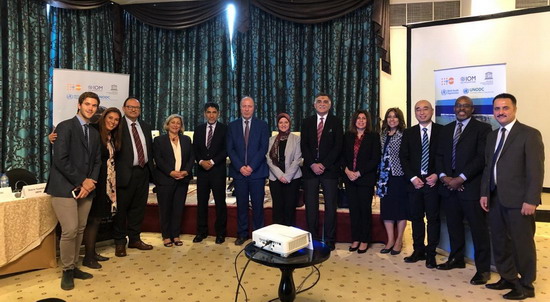
1 October 2019 – United Nations agencies are implementing a joint multi-country programme, which aims to improve and protect the health and well-being of individuals and communities before and throughout the different phases of migration. The programme will be implemented in 9 countries of the Middle East and North Africa (MENA) region: Algeria, Egypt, Libya, Morocco, Tunisia, Iraq, Jordan, Lebanon, and Sudan.
It focuses on the challenges that mixed migration has on women and youth who are particularly vulnerable. These challenges include lack of migrant-sensitive health services in particular adequate sexual and reproductive health, mental health care and psycho-social support, non-existent or inadequate protection mechanisms and legal frameworks, gender-based violence, human trafficking and migrant smuggling.
The objectives of the 5-year programme (2020–2024) are in line with the 2030 Agenda for Sustainable Development and with the comprehensive migration governance framework proposed by the Global Compact for Safe, Orderly and Regular Migration and its overarching principles and aims. It also builds on the momentum created by the landmark conference, which took place in Marrakech, Morocco, in December 2018. It presents a comprehensive and integrated response to the challenges of mixed migration management and so puts into effect the agreed priorities of the Khartoum Process, the Valetta Action Plan, and the Malta Declaration. The programme will establish a platform that can be utilized to initiate a "’whole of government approach’’ to migration, aiming to harmonize national migration governance through national coordination mechanisms.
In recent years, the MENA region experienced an unprecedented increase of mixed migration flows both as countries of transit and destination.
Moreover, protracted humanitarian crises across the region have resulted in significant internal and cross-border displacement. Migrants who left their homes for reasons ranging from escaping hardship because of economic crises, protracted civil unrest, climate change, social marginalization and other reasons find themselves stranded in countries where their status and protection remain fragile. Many have irregular status in transit or destination countries, and are faced wit,h or exposed to, harsh conditions. This has often been exacerbated by lack of access to social, protection services, and intolerant attitudes, which often lead to socioeconomic exclusion and increased risk of violence, exploitation and abuse.
The initiative builds upon and collaborates with ongoing regional and national level initiatives to address mixed migration-related challenges in the Middle East and North Africa and builds upon the strategic partnerships and comparative advantages of the United Nations Population Fund, the International Organization for Migration, the United Nations Office On Drugs and Crime, United Nations Education Science and Culture Organization and WHO, both at the regional and the national levels, with multilateral and regional partners, national governments and civil society organizations.
The United Nations agencies will coordinate their actions and build on their specific expertise to implement multi-faceted and integrated actions and will establish strategic alliances with relevant actors in the MENA Region, such as the League of Arab States, the Organisation for Economic Co-operation and Development, parliamentarian groups, academic institutions and the private sector.
Related links
Global Compact for Safe, Orderly and Regular Migration





